Latex Foam vs. Memory Foam

At the end of the day, you know what’s best for you and your health. That’s why we’ve created this guide to compare latex vs. memory foam mattresses so that you can decide for yourself. Keep reading to discover the similarities and differences between latex versus memory foam mattresses, or use the links below to navigate the post.
- What Is Memory Foam?
- What Is Latex?
- How Are Memory Foam and Latex the Same?
- The Difference Between Latex Foam and Memory Foam
- Layla Sleep Copper-Gel Memory Foam
- How to Choose a Mattress That’s Right for You
- Wrapping Up: Latex Foam vs. Memory Foam Mattresses
What Is Memory Foam?
In 1962, aeronautical engineer Charles Yost helped NASA build a recovery system for the Apollo command module to improve airline seating for crash and vibration protection. The seating Yost created was made from an open-cell, polymeric “memory” foam material with particular viscoelastic properties, which contain both high-energy absorption and soft characteristics. In simple terms, Yost created memory foam, which is a polyurethane foam with added chemicals that’s extremely responsive.
Memory foam boasts many beneficial properties. For one, memory foam mattresses conform to both pressure and body heat, matching your body’s contours to relieve pressure and keep you comfortable. Even better, memory foam mattresses return to their original shape once pressure is relieved, meaning your mattress won’t experience the typical sagging that comes with other mattress types, such as innerspring mattresses.
Memory foam mattresses can also come in different variations. Some memory foam mattresses can be fully or partially infused with gel, gel beads, graphite, copper, or other materials. Additionally, memory foam mattresses can come in various densities, allowing customers to choose a firmness level that they find most comfortable.
Pros of Memory Foam Mattresses
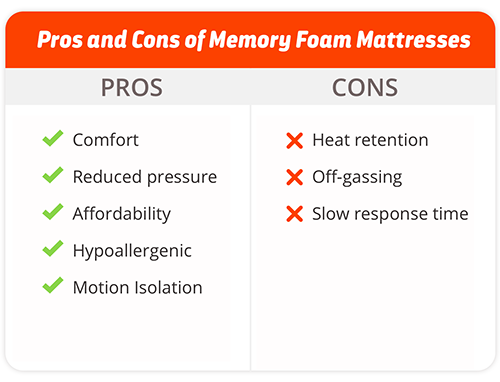
- Comfort: One of the main benefits of memory foam mattresses is their comfort. Memory foam conforms to a sleeper’s body, relieving pressure and pain on pressure points, which results in a night of comfortable, restful sleep.
- Reduced pressure: Memory foam mattresses are also one of the best mattresses for back pain, as they reduce pressure points. Memory foam mattresses are often recommended to those who suffer from chronic pain, back and neck problems, and muscle soreness.
- Affordability: Compared to latex foam mattresses, memory foam mattresses come at a much lower price point, making them more affordable.
- Hypoallergenic: Memory foam mattresses are perfect for sleepers who suffer from respiratory problems or allergies from latex, dust, dust mites, or other allergens, as they contain hypoallergenic properties.
- Motion isolation: Memory foam mattresses completely isolate motion, which means you won’t feel the mattress squeak or shake if they end up waking up in the middle of the night or before you in the morning. This results in a solid night of sleep with no disturbances.
Cons of Memory Foam Mattresses
- Heat retention: Traditional memory foam mattresses are known for retaining heat, which isn’t ideal for hot sleepers. However, new technologies are improving the cooling systems of memory foam mattresses. For example, the copper particles that we use in our Layla mattresses direct heat away from your body while you sleep. You can also invest in cooling and breathable sheets that keep you comfortable all night long.
- Off-gassing: Because memory foam mattresses are made from petrochemicals, they experience off-gassing when taken out of their box or package, resulting in an unpleasant smell. However, this scent only lasts a few days or up to a week.
- Slow response time: Some memory foam mattresses have a slow response time, depending on the type of materials used. This can result in compressions lasting up to a minute in the foam, making the sleeper feel as if they’re stuck. However, high-quality memory foam brands, such as Layla sleep, have improved response times that only last a few seconds.
What Is Latex?
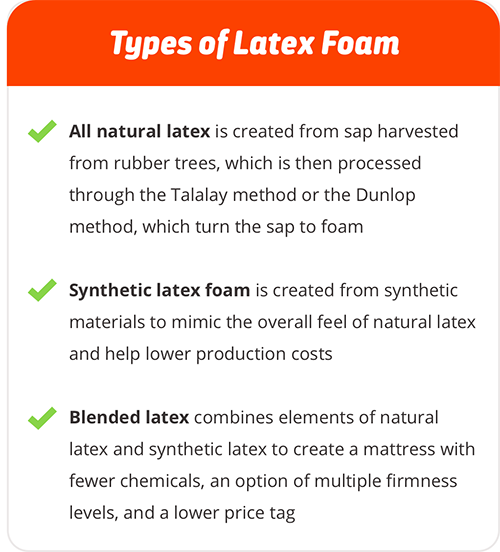
Latex foam is another popular material used in mattresses. However, latex isn’t one and the same. There are actually three different types of latex that you can find in a mattress: all natural latex, synthetic latex, blended latex. Let’s break down each type of latex foam below:
- All natural latex: Natural latex is created from sap harvested from rubber trees, which is then processed in one of two ways: the Talalay process or the Dunlop process. With the Talalay latex manufacturing process, latex is poured into a mold until it’s partially filled. Air is then added to the mold until it expands, resulting in a lighter, more consistent foam. With the Dunlop latex manufacturing process, latex is poured into a mold until it’s completely filled. Once the latex settles, it results in more durable and firmer foam. All natural latex mattresses are a good option for sleepers looking for organic mattresses made from natural materials.
- Synthetic latex: This type of latex is made from synthetic materials, typically styrene-butadiene rubber (SBR). Petrochemicals used to create synthetic latex mimic the overall feel of natural latex and help lower production costs. However, synthetic latex is often described as less durable and less bouncy than natural latex and can have a shorter lifespan.
- Blended latex: Blended latex takes the best of both worlds by combining elements of natural latex and synthetic latex. The end result? A durable mattress with fewer chemicals, an option of multiple firmness levels, and a lower price tag.
Overall, these are the three different types of latex mattresses on the market. Knowing the different types can help you determine whether a latex mattress is right for you, and if so, what type of latex mattress works best.
Pros of Latex Foam Mattresses
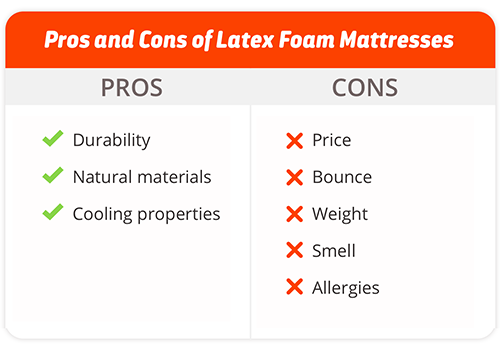
- Durability: Depending on the type of latex used, latex mattresses are extremely durable. Natural latex mattresses can reach up to 15 years old, while synthetic and blended mattresses can last between 6 and 10 years. Latex is also much bouncier than other mattress materials, resulting in a sleeper feeling on top of the mattress rather than sinking in.
- Natural materials: For those looking to avoid petrochemicals and VOCs, all natural latex foam mattresses contain little to no chemicals. Natural latex mattresses also have a smaller environmental impact, which means you can rest assured knowing no harmful chemicals pollute the earth.
- Cooling properties: Latex foam is naturally cooling, which means latex foam mattresses are great for sleepers who sleep hot.
Cons of Latex Foam Mattresses
- Price: One of the biggest drawbacks of latex foam mattresses is their price. Natural latex foam mattresses can cost well over a few thousand dollars, making them one of the most expensive mattress types. However, synthetic and blended latex foam mattresses are often cheaper but come with added chemicals.
- Bounce: Latex foam mattresses are extremely bouncy, which may sound nice at first but can wear on you down the line. Compared to memory foam mattresses, latex mattresses have a harder time controlling motion transfer, which means you’ll feel your partner moving around more during the middle of the night, which can disrupt your sleep.
- Weight: Latex mattresses are very dense, which means they can weigh much more than other mattress types. This can become burdensome when it comes time to move or rearrange a bedroom.
- Smell: Latex foam mattresses are known for having a fairly pungent chemical smell, especially when they’re first opened up from the package. The smell does go away over time but can last several weeks.
- Allergies: A small portion of the population suffers from latex allergies, which means latex foam mattresses won’t be a suitable option.
How Are Memory Foam and Latex the Same?
We know that memory foam mattresses are made from an open-cell, polymeric memory foam, and latex mattresses can be made naturally from sap harvested from rubber trees, synthetically, or blended with both natural and synthetic elements. So, how are latex versus memory foam mattresses the same? The main similarity between memory foam and latex mattresses is that both offer posture support. When you sleep on either mattress, both will conform to your body’s shape to relieve pressure on areas like your neck, back, and spine.
Other than this similarity, latex foam vs. memory foam mattresses are pretty different from each other, especially when it comes to comfort. Let’s explore what sets these two mattress types apart in the section below.
The Difference Between Latex Foam and Memory Foam
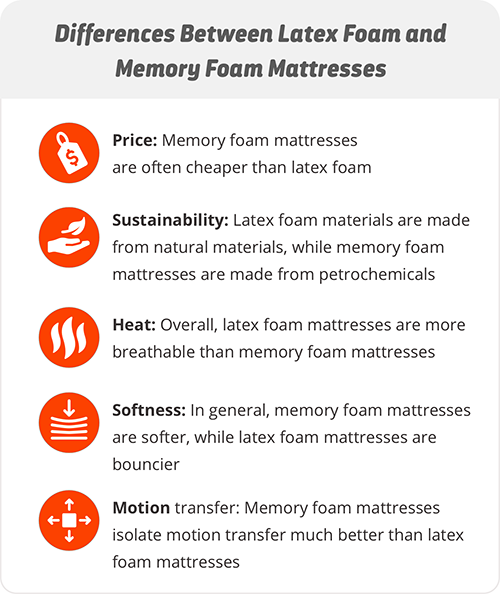
Latex vs. memory foam mattresses are made from different materials, which results in much different sleeping experiences. Let’s analyze the differences between latex foam vs. memory foam mattresses below:
- Price: One of the biggest differences between latex foam beds and memory foam beds is their price. Typically, latex foam mattresses are much more expensive than memory foam mattresses, especially if the mattress is made from all natural latex. You can find memory foam mattresses that fit almost any budget and high-quality memory foam mattresses can still be found around a thousand dollars or less.
- Sustainability: For those looking for an environmentally-friendly mattress, an all natural latex foam mattress might be right for you, as they contain little to no harmful chemicals and VOCs. Blended latex mattresses, synthetic latex mattresses, and memory foam mattresses are all constructed with petrochemicals and other synthetic materials.
- Heat: Overall, latex foam mattresses are much more breathable than traditional memory foam mattresses. This makes latex foam mattresses much cooler than memory foam mattresses. However, new innovations, like gel beads and copper, are making memory foam mattresses much cooler, putting them on an even playing field.
- Softness: Memory foam mattresses are generally the softer option, as the memory foam conforms to the contours of your body while you sleep. This results in reduced pressure on joints like your neck, back, and hips. Latex foam mattresses are bouncier and compress when you sleep on them, but the foam doesn’t match the contours of your body. Instead, it makes a general compression that makes you feel as if you’re on top of the mattress
- Motion transfer: Of the two mattress types, memory foam mattresses are much better at isolating motion transfer. Those sleeping with a partner on memory foam won’t be disturbed if they toss and turn during the night or wake up earlier or go to bed later than you.
As you’re on the hunt exploring different types of mattresses, it’s important to keep their similarities and differences in mind. This way, you can better understand what mattress will suit your body best.
Layla Sleep Copper-Gel Memory Foam
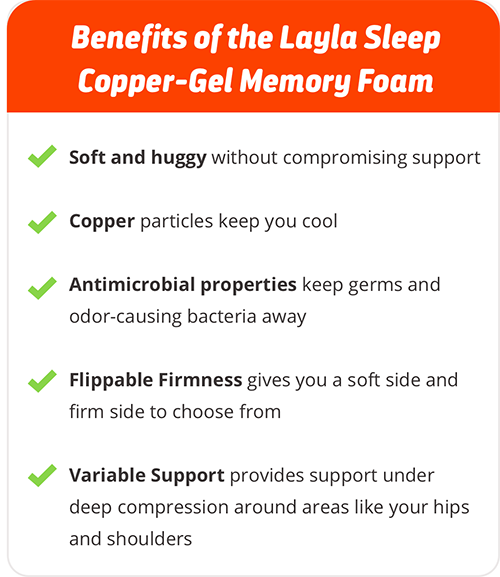
The Layla Memory Foam Mattress is ranked as one of the best memory foam mattresses, and for good reason. What makes the Layla mattress so comfortable is copper foam. The copper gel foam found inside the Layla Memory Foam Mattress reacts to increased pressure with a firming response, resulting in a soft and huggy feel that doesn’t compromise support around deep compression areas where you need it most.
Even better, the copper particles help you sleep cooler because copper is super conductive. While you sleep at night, the copper particles are hard at work transporting body heat away from your body, so you can get a much cooler sleeping experience compared to traditional memory foam mattresses. Below are some other reasons why the Layla Sleep Copper-Gel Memory Foam Mattress might be the right pick for you:
- Antimicrobial: Sleep peacefully knowing no little critters are snuggled up beside you. Copper is antimicrobial and condenses under pressure. When you go to sleep at night, the pressure from your body compresses the copper, which creates an antimicrobial barrier that fends off dirty germs and odor-causing bacteria.
- Flippable Firmness: One of the drawbacks of memory foam mattresses is that they can sometimes be too plush for some sleepers. With Layla’s flippable firmness, sleepers can benefit from two options: a soft mattress on one side and a firm mattress on the other. Side sleepers often find the soft side to be their perfect companion, while back sleepers and stomach sleepers found the firm side with increased support and less sink to be a good match.
- Variable Support: For deep compression areas, Variable Support has you covered. When the copper gel beads inside the mattress compress together, a firming response is triggered in the bead. This response causes the bead to resist further compression, resulting in better support under deep compression around areas like your hips and shoulders. This firming response also prevents that “stuck in the mud” feeling that you get with many other memory foams.
With Layla Sleep, you can experience what true sleep feels like. And if you think our memory foam mattress isn’t right for you, don’t fret. We also have the Layla hybrid mattress, which fuses together the benefits of memory foam mattresses and innerspring mattresses into one ultimate sleeping surface. The main difference between a memory foam vs. hybrid mattress are the materials used. Memory foam mattresses are constructed solely out of memory foam. On the other hand, hybrid mattresses contain a series of individually pocketed coil springs surrounded by layers of memory foam, which create superior edge support and unmatched comfort.
How to Choose a Mattress That’s Right for You
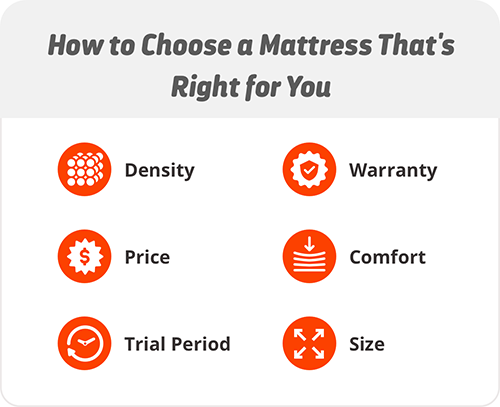
With so many mattresses to choose from, you may be wondering how to pick one that’s right for you. As with any decision, it’s important to do your research and weigh each type of mattress’s pros and cons. It’s also wise to look at latex, hybrid, innerspring, and memory foam reviews to see what customers have to say about different types of mattresses and brands. Some factors to keep in mind to choose a mattress that’s right for you include:
- Density: Memory foam and latex foam mattresses can come in varying densities, which is why it’s important to find one that matches your preferences. Layla Sleep’s Flippable Firmness offers two firmness levels in one, so you can find a side that works for you.
- Price: How much a mattress costs is always an important factor. Make sure to look at your budget and plan ahead, as mattresses can get costly. However, it’s important to remember you spend (or should be spending) at least eight hours a day sleeping, so investing in a high-quality mattress can pay off.
- Trial period: When shopping for mattresses online, you don’t have the luxury of testing them out as you do shopping in-store. That’s why it’s important to see if a mattress brand offers a free trial period. At Layla Sleep, we offer you 120 nights to test out your mattress, and if you’re not satisfied, you’ll get a 100% refund with no return or shipping fees.
- Warranty: Mattresses are a big investment, and the last thing you want is to shell out a lot of money for a defective item, which is why you want to ensure your mattress comes with a warranty. Layla Sleep offers the Layla Mattress Lifetime Warranty if there is sagging more than one inch, cracking or splitting of the foam, and loss of mattress height.
- Comfort: Comfort is critical when it comes to buying a mattress. You want to ensure it’s firm or soft enough for your liking, isn’t loud and squeaky, and keeps you cool. Layla Sleep’s Memory Foam Mattress is your go-to mattress for endless nights of blissful sleep.
- Size: The size of your mattress is also important. Standard mattress sizes include twin, full, king, and queen. To find the right size, think about the dimensions of your bedroom and what will fill the space nicely. If you sleep with a partner, you might want to consider a larger mattress, such as a king or queen, so you both have adequate room for a comfortable sleep.
Wrapping Up: Latex Foam vs. Memory Foam Mattresses
There’s a lot to consider when choosing between a latex vs. memory foam mattress. Overall, memory foam mattresses are softer, with foam conforming to the contours of your body. They also isolate motion transfer to reduce disturbances at night, are more affordable, and are hypoallergenic. Conversely, latex foam mattresses are more sustainable, bouncier, and have natural cooling properties. At the end of the day, Layla Sleep offers one of the best memory foam mattresses on the market. With copper-infused gel beads, you get cooling properties, unbelievable comfort, pressure relief, and support so you can get a great night’s sleep to be your best daytime self.





